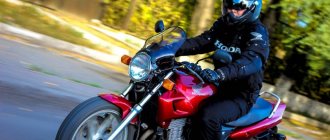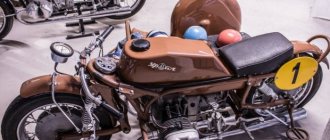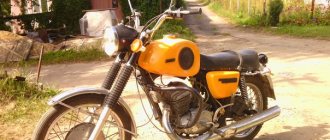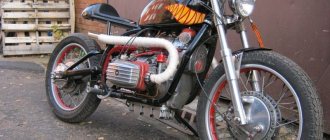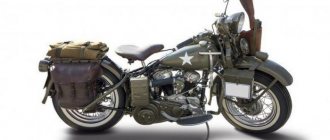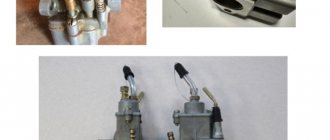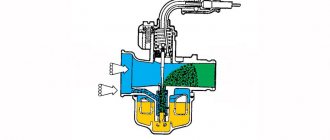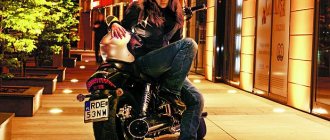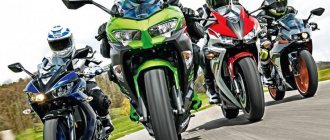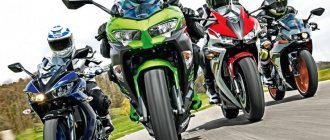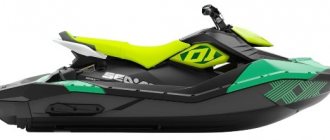- home
- Engine
27.09.2020
Soviet and Russian motorcycles were produced under the Izh brand. Production took place from 1929 to 2008 at . The first prototypes were models IZH-1, IZH-2, IZH-3, IZH-4 and IZH-5, manufactured in the period 1928-1929. They took part in the All-Union Motor Ride. Thus, the developers wanted to evaluate their performance characteristics before launching mass production.
The most interesting were IZH-1 and IZH-2 with a 1.2-liter engine producing 24 hp. With. This engine and the motorcycle itself had an advanced design for its time: a longitudinal shaft, a three-speed gearbox, a massive stamped frame and a front fork (combined parallelogram and lever systems, and were also introduced by designer Ernst Neumann-Neander). All five motorcycles also took part in the second All-Union motorcycle rally, which took place in 1929 and had a route of 3,300 km. In general, the tests were successful, but only the smallest of all prototype models, IZH-4, received approval for serial production.
Then the models IZH-7, IZH-8, IZH-9 and IZH-12 appeared. Their production lasted from 1933 to 1941. After the end of the war, the plant gradually began operating at full capacity. The line of IZH motorcycles has expanded to include models of various classes: road, sports and racing, as well as special equipment. The latest road models are Izh Planeta-5, Izh Jupiter-5, Izh Planeta-7, Izh Junker, etc.
Izh motorcycle engine oil - how often to change
The engine oil in IZH motorcycle engines must be changed every 5 thousand km or earlier, depending on how quickly the lubricant loses its useful properties. Signs of deteriorating fluid quality are insufficient oil level, cloudiness, wear debris in the form of sediment, and a burning smell. The shelf life of the lubricant can be negatively affected by intense driving with sharp maneuvers, sudden starts and braking, frequent off-road travel and towing heavy trailers. All this puts a significant load on the engine, which overheats, and spoiled oil is not able to effectively lubricate and cool the internal combustion engine parts.
You'll find some, you'll lose some.
The Third Planet, due to its lower motor power, was somewhat inferior to Jupiter in dynamics. Owner reviews indicate that this shortcoming was compensated for by better traction at low speeds. This gave certain advantages when driving over rough terrain.
But, despite the fact that the engine capacity of the Izh Planet-3 remained almost the same as that of the two-cylinder unit of the older model, fuel consumption increased significantly. At high speeds it reached 5 liters per 100 km. But the ignition adjustment has been simplified.
Izh Planeta-3 was produced from 1971 to 1977. During this time, 478,496 vehicles of this modification were manufactured. They had minor differences, such as the color of the seat upholstery materials and the side trims on the tank.
Izh motorcycle engine - how much oil to fill
Izh 2.673 Cornet
Izh Cornet is a mini-motorcycle with a ground clearance of 195 mm. Characteristic features of this model are a high steering wheel, disc brakes and chrome parts. The lining is plastic, the footrests are moved forward. Thanks to its compact dimensions, the motorcycle is maneuverable and economical. It is equipped with a two-stroke 2-cylinder engine with a carburetor power supply system and air cooling. The lubrication system is combined (oil mixed with fuel). The estimated speed of the Izh Cornet motorcycle does not exceed 50 km/h.
Year of manufacture: 2001
Two-stroke 2-cylinder, carburetor, 50 cc. cm, 2.21 l. pp., oil volume – 20:1, approval: API-TC
Izh 6.113-020-05 Junker
Izh Junker is a recreational motorcycle with a ground clearance of 175 mm. It is made in the American style, and its distinctive features (compared to its predecessors) are a high steering wheel and a streamlined teardrop-shaped tank. The instrument panel is mounted on the tank.
The developers managed to ensure the comfort of passengers by installing a two-level saddle, which can accommodate just two. In addition, the Junker is equipped with a front disc brake, and a “drum” is installed at the rear.
Also read: Motor oil for Skoda Yeti engine
An updated intake and exhaust system is installed, which is relatively quiet and provides higher thrust at low speeds than previous models. The total production volume of the Izh Junker motorcycle was 6,000 copies, including modifications for special services.
Years of production – 2000-2005
Two-stroke 2-barrel, carburetor, 347 cc. cm, power – 24 l. pp., oil volume – 20:1, approval – API-TC
Izh Planet 7
Izh Planet 7 is a middle-class motorcycle, the successor to the successful Planet 5 model. Owners positively evaluate Planet 7, which has a rather interesting original design, a powerful and economical engine and has high maintainability.
However, there are also disadvantages: low reliability of rear wheel bearings, insufficiently efficient air cooling (especially in hot weather), poor quality assembly and weak traction in versions with a trailer. The Izh Planet 7.107 modification periodically experiences strong engine vibrations.
Next, we note the main improvements compared to its predecessor (Planet-5): a lightweight 4-stroke engine of smaller volume but similar power, an electric starter for starting, a narrower gas tank, new instrument panel and optics with turn signals, electronic non-contact ignition, improved clutch, separate lubrication and five-speed gearbox. The improvements made had a positive effect on the dynamic qualities.
Years of production – 1987-2008
4-stroke, 2-cylinder, 250cc cm, 20 l. pp., oil volume – 2 liters, tolerance and viscosity: API-SG, SH, SJ; SAE 10W-40
Basic modification
Otherwise, Izh Planeta-3 was not much different from its two-cylinder brother. The technical characteristics of these machines were quite similar.
- Engine – air-cooled, single-cylinder, two-stroke. With a working volume of 346 cubic meters. cm produced a power of 18 hp. With. and in this respect it was inferior to its two-cylinder counterpart.
- A carburetor is used to create a combustible mixture. In early modifications this was the K36I, which later gave way to the K62I model. Fuel comes from the tank by gravity.
- The clutch, like the Jupiter, is multi-disc, with an oil bath. Despite all the structural similarity, the parts of these units are not interchangeable. The Izh Planeta-3 motorcycle has a different motor sprocket. There is also a difference in the shutdown drive.
- The gearbox, as well as the clutch, retained the design layout and number of steps. But at the same time, it differs in the switching device and gear ratios.
The remaining components did not have significant differences and can be considered interchangeable. In this form, the weight of the car reached 168 kg, and the maximum speed was 120 km/h. A version of the motorcycle with a sidecar was also produced, designated Izh Planeta-3K.
All motorcycle characteristics
| Overall dimensions of the motorcycle (l*h*sh) | 2115 mm*1025 mm*780 mm |
| Wheelbase, length | 1400 mm |
| Clearance | 135 mm |
| Maximum developed speed | 110 km/h |
| Gas tank, volume | 18 l |
| Estimated mileage per fill-up | 180 km |
| Fuel consumption per 100 km | at an optimal speed of 60 km/h - 3 liters per 100 km, in another cycle - 5 liters per 100 km |
| Fordable | 300 mm |
| Battery voltage | 6 V |
| Front fork | with hydraulic shock absorber |
| Rear suspension | spring with hydraulic shock absorber |
| Clutch type | multi-disc |
| Gearbox type, number of gears | four-speed, two-way |
| Frame design | tubular, welded |
| Brake type | drum, drive - mechanical |
| Wheels | easily removable, spokes arranged in tangent |
| Tire size | 3.59-18″ |
First changes
In 1977, the next version of the motorcycle went into production - Izh Planet 3 01. When creating this model, the developers followed the same path as when modifying the Izh Jupiter. The changes affected:
- Front fender, height-adjustable above the wheel.
- Rear shock absorbers, the design of which has been significantly improved, adding the ability to change the spring preload.
- Power unit. Boosting the engine by increasing the compression ratio made it possible to increase power to 20 hp. With. But this required installing a spark plug with a different heat rating - A-23, increasing the area of the cooling fins and changing their shape.
- The design of the steering wheel, on which rear-view mirrors appeared, and the ends of the control handles received protection for hands in case of a fall in the form of rubber balls.
- Front brake that got a brake light frog.
- Installed standard safety bars that protected the motorcyclist in an accident
The last motorcycle Izh Planeta-3 01 rolled off the assembly line in 1981. By this time, 400,845 copies of this modification had been produced.
Final version
By 1981, specialists from the Izhevsk Machine-Building Plant prepared a new package of modernizations.
- After fiddling with the carburetor, we added 1 liter. With. power., achieving a figure of 21 hp. With.
- A new fuel tank was installed, which was later transferred to the Izh Planet-4 model.
- A rear wing of a new shape appeared. Due to the fact that the production of the part was not yet debugged, the new wing was not installed on all series of the car.
Well, and some other little things. In this form, the motorcycle became known as Izh Planeta-3 02. By 1985, when production of the modification was completed, 216,101 copies had been made.
Warm greetings to everyone! We continue to bring back to life the interesting motorcycle IZH-Planet 3-02. Why is he so interesting? Of course, with its history, which continues to this day. As I remember, we settled on completely disassembling the motorcycle and sending all the spare parts for sandblasting. Well, we have accumulated enough material, we can begin. Go! A couple of days later, when the elements of the crew section were painted and ready for assembly, it was necessary to buy new fasteners. I spent the entire evening writing down all the bolts, nuts, washers, and bolts on the motorcycle and sidecar. The list turned out to be quite long. Eh, the frame is like new. It feels like you are standing on an assembly line and slowly reviving the engine)) The quality of the paint is of course top notch!
The glove compartments, engine mounts, turn signals, traverses, handlebar mounts, steering panels, mudguards also arrived... oh, in general, everything on the motorcycle is black, it all came from painting. Every little detail was painted so that in the end it would not be noticeable.
We begin to assemble the turn signals so as not to lose all the small parts. Of course, when damaged they looked like new. It was very lucky that the glass pieces and the turn signal housing itself were intact, otherwise we would have had to look for them.
Now we move to the frame and begin to assemble this puzzle. I started with the rear mudguard. Instead of the usual BPV 14-10, there is a relay-regulator on its own separate platform. The latest modification of the Planets with a 6-volt ignition.
Next we install the glove compartments. Something is already beginning to emerge, but very faintly...
It came down to the wiring. We carefully place everything in its place, having first washed everything from dirt and dust.
It’s good that during disassembly I signed all the plugs and connectors so that when reassembling, I could quickly connect everything without getting confused. Although there are not many wires here to get confused, but still. Yes, what else did I like about the three? It’s just the wiring. I don’t know why there was a need to hang mountains of wires on the fourth generation... But oh well))
Turn signals... mmm, beauty. The holders were cleaned of plaque and dirt, now everything is shiny and pleasing to the eye.
They didn't even throw out the old clamps. Each of them was sanded with a metal brush to achieve this shine. Now everything is according to the canons of IZHMash))
We install the center stand and rear swingarm. Even on the center stand all the rubber bands were retained. Wow, we went crazy here, paying attention to all the little things. But what will everything look like later?
So, I collected what I had. It was possible to install shock absorbers and a fork, but... they were killed and required a bulkhead. In the garage, the owner of the motorcycle did not have a workbench or yew trees to sort through this stuff. So I convinced him to bring it all to my house. In the afternoon, taking the rear shock absorbers in my backpack, I went shopping to buy consumables for shock absorbers and forks, and also took all the consumables for the engine. Yeah, just for the engine) More on that soon)))) When I arrived home, I immediately disassembled the shock absorbers. Surprisingly, they were like new, with no signs of wear. But all dirty and without oil... hmm, how long they lay interestingly in the basement.
We disassemble everything, wash it, press out the silent blocks. The client wanted to buy new store-bought shock absorbers, but I advised him to sort out the old ones rather than pay 4,000 rubles for new ones. Although consumables for repairs cost only 300 rubles, they will work even better than new ones!
An hour later, the shock absorbers were ready for installation. They look and work better than the new Chinese ones - fact! Another important thing is that the chrome is safe and sound everywhere))
After another hour and a half, the fork feathers were ready. Now the entire suspension has been rebuilt and is ready for installation.
Give me the engine! Give me the engine!!! I can hear someone already wanting to see the engine we found. Here it is, my dear) I already threw in the left cover and the spare parts in it so that you can understand the form in which it came to us.
In general, the original engine was found)) It was lying with a client’s friend in a nearby garage cooperative. Cold basement... Old workbench. The engine lay there for almost 10 years. Even in his youth, his owner gave it to a friend for repairs. But something went wrong. All we found there was a crankcase with a crankshaft, cylinder, clutch drum, a couple of washers and a rusty gear shift mechanism. Hmm, I thought, it was beautifully repaired... Everything was rusty, there was no gearbox, no generator either.
I had to go down to my basement and add some spare parts to the engine. Well, some! I supplied almost half of the engine from my own reserves (not for nothing, of course). In general, the following had to be taken out of the basement: engine cover, generator assembly, internal clutch drum with all springs, bolts and cups, gearbox assembly, gear shift mechanisms, gear lock, clutch ratchet, crescent assembly. Hmmm... luckily he gave the engine away for repairs)
Inside the standard is dirt. And the speed lock was lost...
The bearing race is licked by the fallen off ratchet spring.
The crankshaft brought another surprise. He left his place. I don’t know how to turn the engine to screw up the crankshaft at 383 km. Apparently there was more than enough enthusiasm.
After washing the crankcases, they were as good as new, my hands began to pick them up! But they were not washed out so quickly. I'm tired of fidgeting with the brush... I pumped up the compressor, poured gasoline into the engine compartment and drove off! A powerful jet of gasoline wiped everything out of its path; all that remained was to wipe it with a cloth. Lapota)))
But without a crankshaft there was nothing to assemble... That same evening the client brought from the garage, ATTENTION, a new, completely new, packaged crankshaft from IZH-49! Just imagine, the spare parts are already 50 years old, and it’s completely new. It took a long time to persuade him to bring it, since he did not believe that this crankshaft would fit. And it will fit)) What a miracle... My mouth started watering when I saw it, seriously) The first time I saw it was when I was dismantling the IZH, and so I asked to bring it)
How much grease was there... It was as if he had been dipped into boiling grease and wrapped in newspapers. First, I scraped off the grease with a knife, then washed it with gasoline again. Then I heated it up with a torch to make it easier to clean. About an hour later the crankshaft was reactivated.
The replacement of the bearings in the crankcase was successful and the new crankshaft was installed in the crankcase after centering it in the crank chamber.
The gearbox is assembled, adjusted and tested. Now you can install the cover with the secondary shaft.
We also finish assembling the clutch. There is very little left.
Well, that's it, almost the finish line. We install the piston in Chelyabinsk. After a little experience with new pistons, we decided that Chelyabinsk was better. Izhevods know that the piston is first heated, then a finger is inserted and it should go in without much effort. Rostov pistons warm up no matter how much, but you still have to pin your finger a little. But with Chelyabinsk ones everything is simpler, they are installed without much effort - just warm them up a little and everything goes in by hand, according to the repair books, this is how everything should be assembled.
Well))) The carburetor was washed, the air filter finally got rid of a giant layer of dirt. Now the engine is ready to be installed on the frame, and then to conquer our roads. Everything is clean, washed, assembled, adjusted ehhh, you look and rejoice) The piece of iron was lying around idle and now it’s back in service!
That's it, end of the day, the engines are on the shelf waiting. Next to it lies an engine from Jupiter 5. Both engines arrived to me on the same day - Friday. I started doing them on Saturday morning and finished by Sunday evening. That's how the weekend spent working on the engines)) I looked at them at the end and thought, “Well, let's take them to the bathhouse!” and went to the bathhouse to wash off the oil, gasoline, and sealant))
Now we move to the garage already in the city. The owner took all the goods and brought them to him. Now we mount the shock absorbers in their place. Slowly something is already molding)
As previously mentioned, we pay attention to every detail. Here is the shock absorber bolt retainer. Before installation, we clean and sand it to make it look like new.
The moment is simply heartbreaking!!! The frame and engine found each other after 10 years of separation. Who would have thought that everything would be found and come together like this! The heart is now in its place.
The day was drawing to a close. Installed the fork and tightened the engine. We installed the front fender. That's it, it's time to go home and rest.
And tomorrow we’ll have to sort out the rest of the spare parts and remove the excess...
The next day began with installing the steering wheel, connecting the headlights, pulling cables and wiring.
We assemble the painted remote controls and mount everything on the steering wheel. The original screeds were also polished to a shine. Now we put everything as it should be!
Wiring, installation of headlights, and connection of remote controls are completed. Everything is stretched as needed - neatly! Now we checked the wiring. Everything worked except the low beam, it wouldn’t turn on. Even before this, I was confused by the lack of a light switch on the right remote control. These remote controls were like those of the fours, which were a new model at that time. I thought maybe the owners had removed everything from the remote control. So I had to remove the remote control again and install the light switch from the spare remote control that I took. I installed it, looked at it and thought that something was wrong here... There weren’t enough wires to connect. I started looking for wiring diagrams for the troika. I found it only from the earliest threes, where the other remote controls are. I smoked the manuals and smoked them!!! It dawned on me that the light switch is located in the headlight itself (I have never encountered threes, so I was dumbfounded). Well, what confused me at first was that the remote control was a half-dummy, where the switch is supposed to be. But the owner didn’t remember whether there was anything there or not... So I had to waste time on this nonsense. As it turned out later, the low beam burned out in the light bulb. There were 5 lamps, and the low beam filament in each one burned out. That's why I started messing with the remote control. Then it dawned on him that when they started demanding that they drive with lights, all their lamps burned out. Eh... how I broke my head there)) But everything turned out okay.
Now let's lower the motorcycle to the ground! I remembered the tradition of sailors when, when launching a new ship, they hit a bottle of champagne on the side so that everything would be fine. We also wanted to do something similar, but we remembered that the lining is new and it’s not fun to hit it, so we just took it off the table and rolled it)) Now it’s on wheels! The first meters...
We tighten the chain and adjust the rear brakes.
Adjust the position of the steering wheel. We tighten everything - the front corners, the headlight.
Everything shines, almost like new. Wow... gorgeous. I'm having fun...
Now we finally secure everything to the steering wheel. And we think about what to do next.
The tank has arrived from painting! Simply beautifully painted! It was painted at the service station, so they did a great job.
Now we attach the muffler, having cleaned them in advance. We are preparing for a test run. I like him even more in this state.
Now the stage of dancing with a tambourine begins. Ignition... First I set everything up. Everything is fine. We check for a spark, but there is none. What a surprise... We checked all the plugs and so on - zero emotions. We connected the battery directly to the coil, same story. I’m sitting thinking... I turn the crankshaft with the key and think further. I took a closer look - the eccentric on the cams is strange. The owner found this eccentric for me in the garage and said that it was there. I took it off and looked and realized that it was from Jupiter! But the eccentrics of planets and Jupiters are not the same! So, we change it to planetary. Still nothing. Well, I think we've arrived. We start according to the standard: spark plug, high voltage, coil, conductor. We took everything new to check it out. But before that, I decided to check the generator connection diagram again and found another jamb. The stator was from Jupiter, which is why there were two places to connect the cam. I hooked it up to the place where there was no food))) I admit, I was wrong. I picked it up - but still nothing! When they put on a new coil with a new wire, the spark was great, as they say, “it would kill an elephant.” Then the owner wanted to try the old coil, he was reluctant to pay 500 rubles for a new one if the problem was only in the high voltage. We picked up the old one - there is a spark. Great!!! Getting ready to start. Filling the carburetor. Tyrk - nothing, once again - a weak flash. There is a spark, there is fuel, but there is no use. They decided to use the pusher... They rolled him and rolled him, no signs of life at all. I started adjusting the ignition again, and not even just one more time, but 6-7 times. I had already adjusted it to such precision that it was awkward to climb into it. Then the client left on business, and I began to think what it was... After thinking, I decided to take a new reel from the store and try it. I put it on, click - the spark is simply ardent. Wow! Everything is clear: the armored wire, coil, and condenser became inoperative after 15 years of inactivity in a cold garage. Well, I think it’s time to start it, infuriate me with the kick starter.
Well, I stretch my legs, fill the tank, hook up the battery.
He stomped once and came to life! Yep, he's alive! Earned!!! Urrrraaah! Immediately I started working stably without failures. Wow, what a clear sound, not a single extra knock. Klaaaas. I warmed it up and turned it off for a while. I called the client and said: rejoice, it started!.. After 5 minutes he was already standing by the motorcycle and personally rejoicing at this success. He hadn’t heard it for so long that he fell into childhood and simply beamed with joy)))
IZH is alive! Everything works)) The hardest part has been overcome! There is very little left. Now we are waiting for the glove compartment lids and stroller to be painted. There is little left for the motorcycle itself: put on the glove compartment lids, put on the ignition cover, pump up the tires, adjust the carburetor mixture and you can go for a run-in on it! This concludes part 2. This is the kind of progress we have. I think the next part will be the final one. There I will finish everything, finish with the sidecar and it will be possible to hand over the motorcycle to the owner. On this note, I say goodbye and see you again))) Part 3 will be coming soon 
